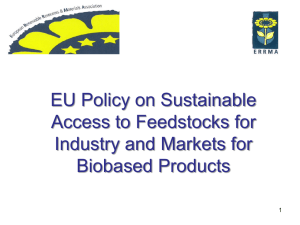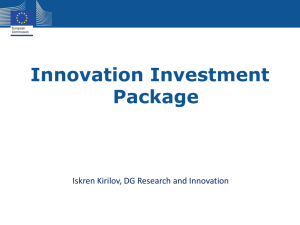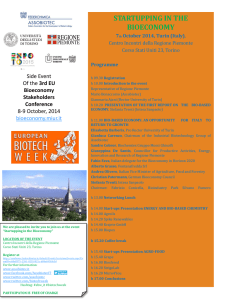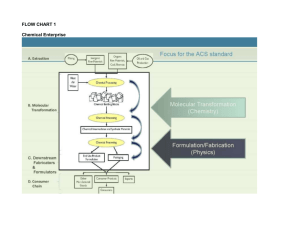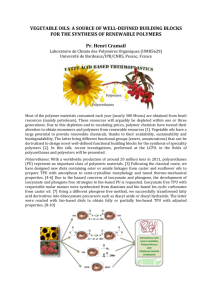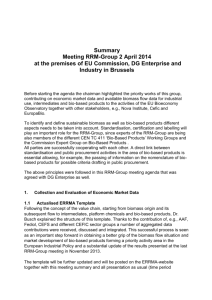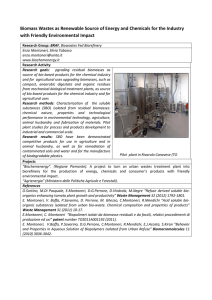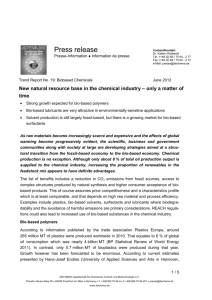March 6, 2013
advertisement
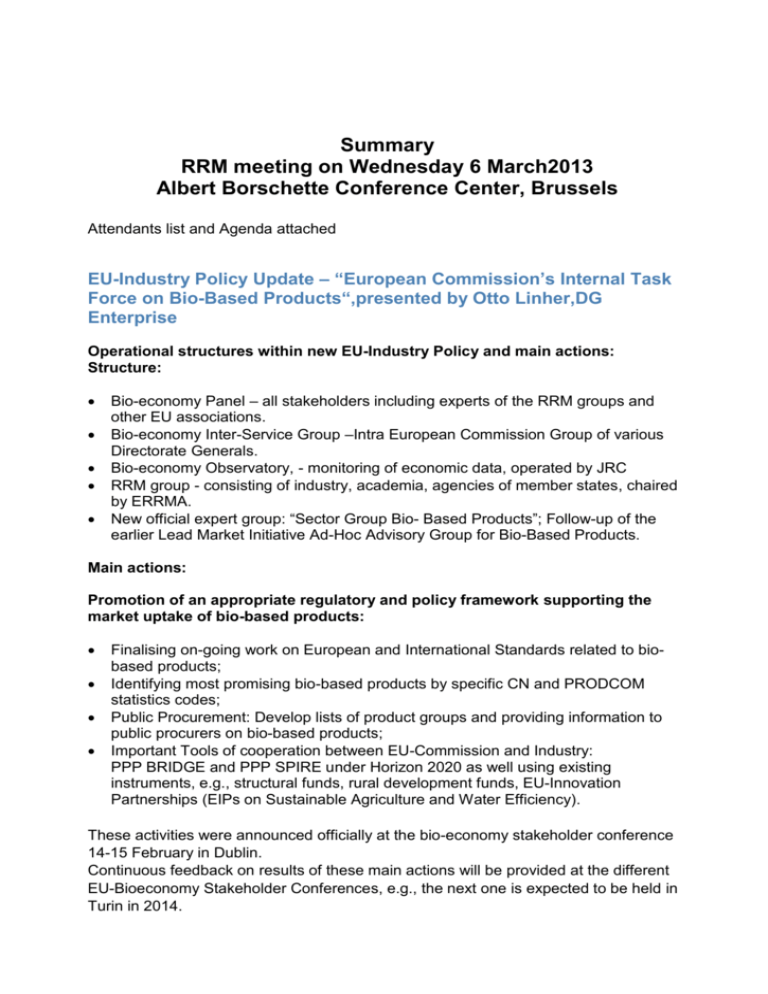
Summary RRM meeting on Wednesday 6 March2013 Albert Borschette Conference Center, Brussels Attendants list and Agenda attached EU-Industry Policy Update – “European Commission’s Internal Task Force on Bio-Based Products“,presented by Otto Linher,DG Enterprise Operational structures within new EU-Industry Policy and main actions: Structure: Bio-economy Panel – all stakeholders including experts of the RRM groups and other EU associations. Bio-economy Inter-Service Group –Intra European Commission Group of various Directorate Generals. Bio-economy Observatory, - monitoring of economic data, operated by JRC RRM group - consisting of industry, academia, agencies of member states, chaired by ERRMA. New official expert group: “Sector Group Bio- Based Products”; Follow-up of the earlier Lead Market Initiative Ad-Hoc Advisory Group for Bio-Based Products. Main actions: Promotion of an appropriate regulatory and policy framework supporting the market uptake of bio-based products: Finalising on-going work on European and International Standards related to biobased products; Identifying most promising bio-based products by specific CN and PRODCOM statistics codes; Public Procurement: Develop lists of product groups and providing information to public procurers on bio-based products; Important Tools of cooperation between EU-Commission and Industry: PPP BRIDGE and PPP SPIRE under Horizon 2020 as well using existing instruments, e.g., structural funds, rural development funds, EU-Innovation Partnerships (EIPs on Sustainable Agriculture and Water Efficiency). These activities were announced officially at the bio-economy stakeholder conference 14-15 February in Dublin. Continuous feedback on results of these main actions will be provided at the different EU-Bioeconomy Stakeholder Conferences, e.g., the next one is expected to be held in Turin in 2014. -2- Establishment of the European Commission, DG Enterprise and Industry “Sector Expert Group Bio-Based Products” presented by Hilda Juhasz, DG Enterprise Following the LMI recommendations for Bio-Based Products 2008 – 2011 this new group will focus on demand side policy including: Standardisation, certification, labeling. Public Procurement for bio-based products. Data Monitoring, linked to the activities of the EU-Bioeconomy Observatory. Communication and Consumer Awareness. This group will also contribute to the implementation of the EU-Bioeconomy Strategy and Action Plan via contributions to the Bioeconomy Panel, PPPs BRIDGE and SPIRE as well as EIPs. The EU-Bioeconomy Strategy and Action Plan are described in the Communication of the European Commission entitled “Innovating for Sustainable Growth: A Bioeconomy for Europe", (COM(2012) 60 final and SWD (2012) 11 final. The following actions are especially important with respect to demand side innovation policy activities: Action Plan – action no. 10: PPP for bio-based products (BRIDGE); Action Plan – action no. 11: standardisation, public procurement, awareness creating. The industrial policy flagship is described in the Communication of the European Commission entitled "A Stronger European Industry for Growth and Economic Recovery. Industrial Policy Communication Update", COM(2012) 582 final where biobased products form one of six priority action lines and a roadmap for Bio-based Products is currently being prepared. The mandate of the European Commission, DG Enterprise and Industry “Sector Expert Group “Bio-Based Products” will include: to ensure the implementation of the LMI priority recommendations in the current policy framework; to ensure that the bioeconomy strategy covers the whole value chain from research to market, from biomass to bio-based products and considers the specific needs and contributions of the bio-based products sector; to contribute to the objectives to be outlined in the Roadmap for Bio-based Products in the framework of the reviewed industrial policy. Members of the European Commission, DG Enterprise and Industry “Sector Expert Group “Bio-Based Products” are expected to include representatives from: -3- National Government Representatives or Competent Authorities of Member States, Business and/or industry associations, Experts on , e.g., public procurers, labeling, standardisation experts, representatives of European chambers of commerce and the European Chemical Regions Network (ECRN), Non-Governmental Organisations, Academics. Eligibility Criteria include: Legal entity registered in one of the Member States and in the EU Transparency Register. Selected experts should be proven as acknowledged personalities respecting an overall view on different aspects of bio-economy. Call for applications was published on 13 February 2013, Deadline 27 March 2013 (prolonged 27 April 2013). Members of this expert group will be selected by an EC Selection Committee. The first membership mandate for this group will have a duration of four years. Its first meeting is expected for the end of June / early July 2013. Experts of the RRM Group are welcome to submit their application. Progress EU-Bioeconomy Observatory presented by Damien Plan, DG Joint Research Center (JRC) This EU-Bioeconomy Observatory is led by the DG Joint Research Center (JRC) and its latest developments include: • December 2012: JRC proposal to RTD on the "set-up of the Bioeconomy Observatory"; • February 2013: RTD-JRC agreement on a project to set-up the Bioeconomy Observatory; • Commission Press Release (IP/13/113) of 14/02/13 "Commission to launch Bioeconomy Observatory"; • Three-year project (Q2-2013 – Q1-2016) – one single partner: JRC. The Work Packages are: • WP1: Definition of appropriate methodology for the Observatory • WP2: Development of ICT infrastructure • WP3: Data collection, data analysis, data dissemination for Research, Policy, Markets (this will be a priority work of the RRM group): -4- First data set based on existing databases e.g. from RRM Group. Timetable: until 02/ 2014. Second data set and first annual report until 02/ 2014, Third data set and second annual report: until 02/ 2016 • WP4: Coordination and Stakeholders relations Actors include: Internally: JRC Externally: EU Commission services, EU Member States, International organisations, key Third Countries and stakeholders like industry associations and expert groups including the RRM group. First thoughts on market estimations for specific bio-based product groups - Example: bio-based solvents, Cefic Sector Group ESIG Solvents are products which are the basis for different sectors from paints and coatings to household, microelectronics, adhesives, rubber production and are invaluable to achieve the purity required of modern medicines. Political Background for bio-based solvents is: Biofuel objective; EC visions to develop bio-based economy; “Innovating for sustainable growth: a Bioeconomy for EU”; EC mandated CEN to develop European Standards: CEN TC 411 is established working on European Standardisation Documents for bio-based polymers, biobased lubricants, bio-based surfactants and bio-based solvents. The objective of CEN TC 411 is to support the development of European Standardisation Documents for different bio-based products allowing description of these products including their capabilities for businesses, consumers, public procurers, etc. Key principles include: Apply sound science; ensure sustainable application and high product performance. Different types of solvents need to be considered, e.g., mixtures of bio-based and nonbio-based raw materials will be presented according the requirements on CEN standards for bio-based products. Within this group there was consensus that a classification should be focused on different groups depending on their measured percentages of their bio-based content. Robust technical and statistical market data as well as performance assessment is needed. -5- Bio-based solvents should comply with the chemical legislation in Europe (REACH) and follow classification and labeling and sustainability indicators and assessment approaches will be defined in WG 4 of CEN TC 411. The European solvent market is estimated at 5 millions of tons yearly. Different numbers have shown that current 1.5% of solvents are globally produced out of biomass. Since there exist no clear statistical data, the group welcomed the initiative of RRM and European Bioeconomy Observatory to establish market data. There was consensus in the RRM group that hard work is necessary to verify market volumes and define bio-based solvents building upon CEN activities, as it was performed for other bio-based products like bio-based polymers and bio-based lubricants. These activities can provide help. A report on bio-based surfactants will follow and will be presented and discussed at the next RRM-Group meeting. Public Private Partnership Bio- Based Industries (BRIDGE) - Joint Technology Initiative reported by Jens Hoegel, DG RTI DG Research and Innovation reported about progress on this since November 2012. The first draft of the Industry Consortium Biobased to Growth was worked out August 2012 and passed on to DG Research and Innovation for internal review in January 2013. The on-line Stakeholder consultation on this document closed in December 2012. A successful stakeholder event on 9 January 2013 confirmed and supported the activities demonstrating the progress in negotiations with industry on objectives, research agenda, budget and governance. As result of the consultation it was obvious that EU competitiveness on primary production, logistics and storage was judged well established in the global context, whereas the commercialization of bio-based products, EU measures for market developments, harmonization and standardisation has to be further developed. The strength and weakness of the European bio-based industries PPP was also demonstrated in the area of research. Basic research, investment of the private sector in research and patent applications industries engagement was seen strong. The investment of the public sector in research and innovation as well EU wide coordination of applied research, collaboration between stakeholders along the value chains, involvement of primary producers (farmers etc.) and access of industries in demonstration plants need a more systematic approach to strengthen these areas. It was clearly mentioned in the answers of stakeholders that intervention at EU level is mostly needed to help industry address the problems. -6- The following top items were identified: Facilitate more rapid deployment of technologies in pilot, demonstration on industrial scale plants. Boost EU-leadership in technologies for conversion of lignocellulosic biomass and other non-food feedstock (residues, waste). Effective collaboration on research and innovation between all stakeholders along the value chain is urgently needed. As a consequence: A public private partnership is the most appropriate mechanism to achieve the aims. Therefore the implementation of the European Bioeconomy Strategy, Industrial Policy Communication and Horizon 2020 including PPPs have most strategic priority. ACDV Congress and Exhibition” Plant-Based Summit” 19. and 20. November 2013 in Paris; State of Progress, reported by Chrietophe Rupp- Dahlem, Roquette/ ACDV (FR) The main areas will be: Fostering European Biobased Chemistry and its Applications; To speed up the development process, all operators in the value chain need to deal with environmental issues, industrial and investment challenges bringing companies together to move towards an integrated plant based chemicals supply chain, achieving technology scale up and exploring business opportunities (industrial formulation, packaging, bio-cosmetics, plastics, etc.). The aim is to bring key business leaders under “one roof” joining the platform involving all partners. Three types of participants: Bio-based products manufacturers; Bio-based products downstream actors (transformators, distribution network etc.); Bio-based economy stakeholders. From all parts of the chemical industry value chain starting from raw materials production, process converters, specialized, e.g., in biorefinery projects, industrial endusers as well as investors, researchers, equipment suppliers (engineering) and financers will have the floor in this conference and exhibition facilities. To give this conference the political dimension representatives of different DGs, e.g., Research, Enterprise, Agriculture will contribute. From EU-Member States France, Germany and the Netherlands will report on their national activities to speed up Bioeconomy. The final program is being prepared and will be published in due time. -7- Efficient use of resources and the cascading concept: Example wood The entire value added concepts of the pulp paper and wood working industry was quantified by the CEPI study on the European Wood Flow and the Cascading use of wood: Resource consumption by sectors; Cascade effects from residues in the wood production process; Advantages of paper recycling; The small amounts of disposals; Energy use from forest resources, industrial residues, waste; CO2 sequestration in wood products. This study contains the wood resource balance, the Forest Resource, the direct use on wood by sectors from flows between the different wood sectors, the energy production from pulping residues, recycling and the energy use by type of installation. Commission representatives judged this study as a helpful example for the cascading system in industry. This concept follows the RRM industry position. Feedback from last CEN TC 411 “Bio-Based products” and its WG 4: Sustainability and LCA Meetings report Camille Burel, Roquette Report on the status of the CEN TC 411 work. The 4th meeting of the CEN TC 411 was held in Stockholm on 28 February. Reports of activities were presented by the Chair of each working group. Key progresses are outlined. Working group 1 – Terminology A draft EN (European norm) document has been agreed in the working group with 22 general terms for biobased products. Definitions applying specifically to the working groups will be added to their standards. The consultation for commenting of the norm will start in March 2013 for a duration of 3 months, this means all Member States mirror group of the CEN TC 411 will receive the document for formal comments. Working group 3 – Biobased content Two draft documents are in preparation: - a TS (technical specification) on Determination of bio-based carbon content. The consultation will be launched in June. -8- - a TR (technical report) on Determination of bio-based content (including description of methods for analytical determination of the biobased or biomass content and methods for mass balance). The consultation will be launched in June. The working group has already started the work to develop a TS document. Working group 4 – Sustainability criteria and LCA Two documents are in preparation: on sustainability criteria for biobased products and on life cycle assessment. Major progress has been done on the scoping of work. Draft EN documents are expected for February 2014. The work item ‘sustainability criteria for biobased products’ is focusing in first instance on sustainability criteria for biomass, as this is the common denominator for all biobased products and the issue raising most questions. For this, existing standards (e.g. ISO PC 248) and certification schemes (e.g. ISCC+) are being considered. It is expected that criteria defined here are mostly focusing on good management practices, quantitative indicators being mostly established through LCA (and thus considered in the second document). Criteria for products will be considered in a second phase of the document drafting. The work item Life Cycle Assessment is focusing on providing methods and guidance for aspects of LCA which are specific to biobased products. It is however understood that the LCA results will of course be for the entire products and the entire life cycle, for which the ISO standard 14040 and 14044 (establishing the framework for LCA) and product specific standards will apply. Working group 5 – Declaration and certification Working group will work on the basis of in particular WG3 and WG4 input to develop standardized communication tools (e.g. environmental declaration sheet). A survey has been carried out on possible format and indicators that could be used in B-2-B and B-2C communication. Results will be further considered by the working group to identify needs of communication in the market and relevant format/indicators for the different communication targets. Further work will be done on verification/certification when the other working groups are more advanced. Working group 2 – Biobased solvents Working group 2 is developing an EN standard on biobased solvents (only vertical working group with a product specific scope, as it could not be attached to an existing TC, as was the case for ongoing work on bioplastics, biolubricants and biosurfactants). The group will focus on an EN to characterize biobased solvents along 4 main axes: biobased content, performances, sustainability assessment, and compliance with -9- legislation. The work will also draw upon expertise and documents of the other ‘horizontal’ working group. The draft EN is expected in February 2014. Update CN/PRODCOM Codes for Exemplary Bio-Based products Report Achim Boenke/ DG enterprise and Rolf Luther, Fuchs, chairman biolubricants,RRM Group As follow-up of the report of the last RRM meeting on the 12 March and 7 June 2012 (s. summary on point 2 of the former agenda to be downloaded on www.errma.com) the meeting with DG Enterprise and DG TAXUD, EU-Member States Custom Laboratories on 7 February 2013 has received positive reaction identifying, three additional codes for exemplary bio-based products including, i.e. bio-based lubricants, bio-based succinic acid and bio-based 1,4-butanediol that were also candidates of the RRM group for possible new codes. The discussion concentrated on bio-based lubricants. Two options were discussed: Splitting the existing Code for liquids for hydraulic purposes, and Splitting another existing Code including all bio-based lubricants. It was very helpful that the group bio-based lubricants established the description for bio-based lubricants: bio-based carbon content of equal more 25 % and biodegradability larger or equal to 60% according to an OECD method. It was recommended that the prefix “bio-based” instead of the prefix “bio” is used in order to be in line with the existing CEN definition of bio-based products. It was extremely helpful, that examples for quantitative information were given by the RRM group last year. More detailed information on other hydraulic fluids as well as candidates on top value added chemicals form biomass, e.g., 1,4-butanediol and succinic acid can be downloaded. The issue of costs for method that need to be used for the verification of bio-based lubricants was also discussed. The concept of using screening and confirmatory methods to reduce measurement and verification costs was explained. Different samples of lubricants for “round robin test” are current being prepared and distributed by Fuchs allowing European Custom Laboratories to make themselves familiar with this testing concept. This approach was judged from DG Enterprise as a cost effective measurement and verification concept for the verification of the proposed CN and PRODCOM Codes. - 10 - - 11 - AOB Date of the next RRM meeting: - 18 September 2013. 13 November 2013 Both in the premises of DG Enterprise and Industry. 12.4.2013
